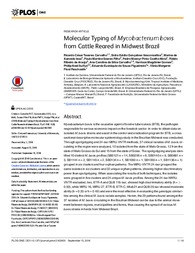Molecular typing of mycobacterium bovis from cattle reared in Midwest Brazil.
Molecular typing of mycobacterium bovis from cattle reared in Midwest Brazil.
Author(s): CARVALHO, R. C. T.; VASCONCELLOS, S. E. G.; ISSA, M. de A.; SOARES FILHO, P. M.; MOTA, P. M. P. C.; ARAUJO, F. R.; CARVALHO, A. C. da S.; GOMES, H. M.; SUFFYS, P. N.; FIGUEIREDO, E. E. de S.; PASCHOALIN, V. M. F.
Summary: Mycobacterium bovis is the causative agent of bovine tuberculosis (BTB), the pathogen responsible for serious economic impact on the livestock sector. In order to obtain data on isolated M. bovis strains and assist in the control and eradication program for BTB, a cross sectional descriptive molecular epidemiology study in the Brazilian Midwest was conducted. Through spoligotyping and 24-loci MIRU-VNTR methods, 37 clinical isolates of M. bovis circulating in the region were analyzed, 10 isolated from the state of Mato Grosso, 12 from the state of Mato Grosso do Sul and 15 from the state of Goiás. The spoligotyping analysis identified 10 distinct M. bovis profiles (SB0121 n = 14, SB0295 n = 6, SB0140 n = 6, SB0881 n = 3, SB1144 n = 2, SB1145 n = 2, SB0134 n = 1, SB1050 n = 1, SB1055 n = 1, SB1136 n = 1) grouped in six clusters and four orphan patterns. The MIRU-VNTR 24-loci grouped the same isolates in six clusters and 22 unique orphan patterns, showing higher discriminatory power than spoligotyping. When associating the results of both techniques, the isolates were grouped in five clusters and 24 unique M. bovis profiles. Among the 24-loci MIRUVNTR evaluated, two, ETR-A and QUB 11b loci, showed high discriminatory ability (h = > 0.50), while MIRU 16, MIRU 27, ETR-B, ETR-C, Mtub21 and QUB 26 loci showed moderate ability (h = 0.33 or h = 0.49) and were the most effective in evaluating the genotypic similarities among the clinical M. bovis isolate samples. Herein, the 29 patterns found amongst the 37 isolates of M. bovis circulating in the Brazilian Midwest can be due to the animal movement between regions,municipalities and farms, thus causing the spread of various M. bovis strains in herds from Midwest Brazil.
Publication year: 2016
Types of publication: Journal article
Unit: Embrapa Beef Cattle
Keywords: Bovine tuberculosis, Brazil, Cattle, Molecular epidemiology, Mycobacterium Bovis
Observation
Some of Embrapa's publications are published as ePub files. To read them, use or download one of the following free software options to your computer or mobile device. Android: Google Play Books; IOS: iBooks; Windows and Linux: Calibre.
Access other publications
Access the Agricultural Research Database (BDPA) to consult Embrapa's full library collection and records.
Visit Embrapa Bookstore to purchase books and other publications sold by Embrapa.

